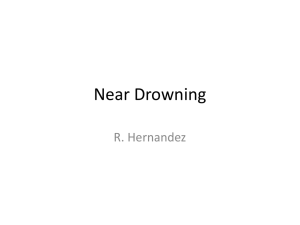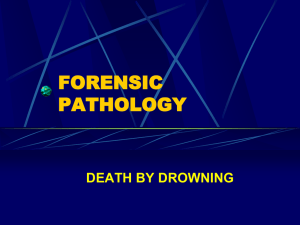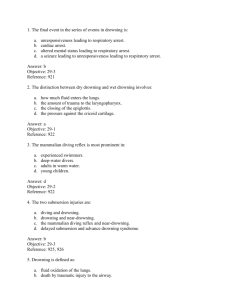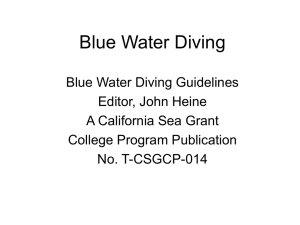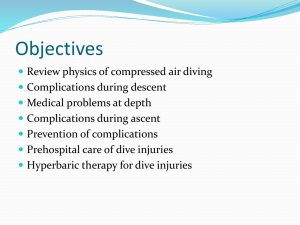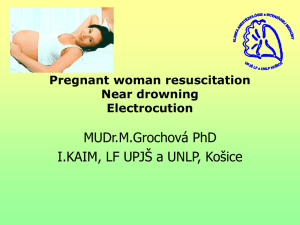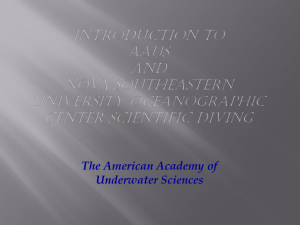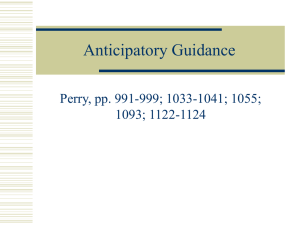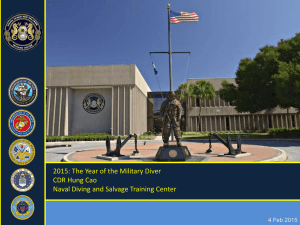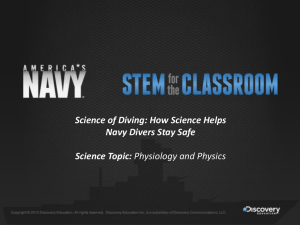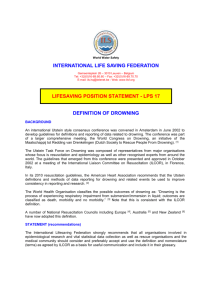YELL – Reach – Throw – Row – GO
advertisement
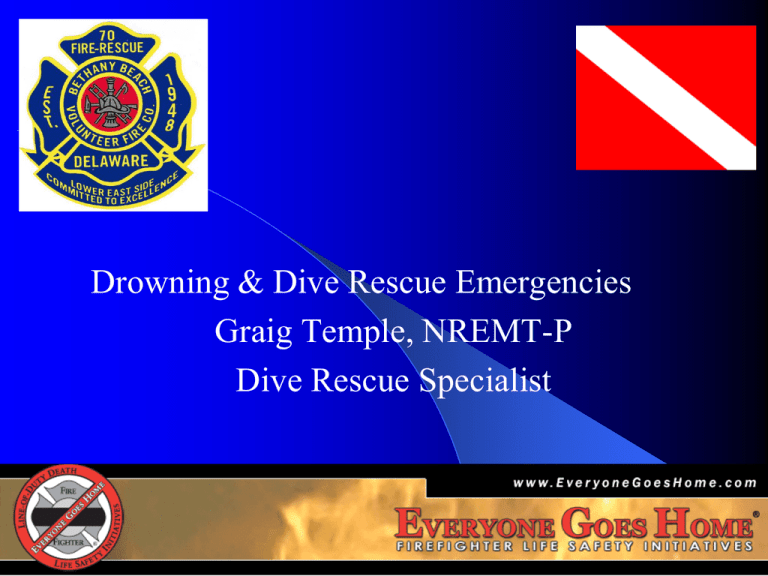
Drowning & Dive Rescue Emergencies Graig Temple, NREMT-P Dive Rescue Specialist Objectives Students shall be able to differentiate between an Active and Passive Drowning. Students shall be able to explain the difference between a Near Drowning verses an actual Drowning including signs and symptoms. Students will be able to compare and contrast a fresh water drowning verses a salt water drowning. Objectives Students shall be able to identify a RipCurrents in typical surf conditions Students will obtain a basic knowledge of Yell - Reach – Throw – Row – GO Objectives Students shall be able to identify various types of dive related emergencies along with their associated signs, symptoms and immediate treatments. Students will be able to describe basic scene management of a dive emergency Students will be able to identify basic components of SCUBA gear including Drowning Definition - Die by immersion in water: to die by immersion and usually suffocation in water or other liquid, or kill a person or animal in this way. Death occurs either from lack of oxygen or as a result of cardiac arrest from the lowered body temperature. Active Drowning Conscious Victim Thrashing Vertical in water Unable to call for help Body may be low in the water Passive Drowning Unable to stay afloat Unable to fight on the surface Submerges Becomes apneic Body floats on surface or could sink Cardiac Arrest imminent Near Drowning Definition – a person who nearly drowns from suffocation in a liquid: Injury occurs as of a direct result of the suffocation but does not result in death. Near Drowning Signs and Symptoms Abdominal distention Bluish skin of the face, especially around the lips Chest pain Cold skin and pale appearance Confusion Cough with pink, frothy sputum Irritability Lethargy No breathing Restlessness Shallow or gasping respirations Unconsciousness Vomiting Fresh Water Drowning A type of drowning in which hypo-osmolar water compromises the surface tension of alveolar surfactant, causing an imbalance in the ventilation-perfusion–V/Q ratio, with a collapse of some alveoli, and both true– absolute, and relative–intrapulmonary shunting Fresh Water cont. If the drowning or near drowning occurs in fresh water and water enters the lungs, that water is quickly absorbed into the blood stream. Fresh water has a lower solute concentration than the plasma in the pulmonary capillaries; therefore, the fresh water is absorbed across the alveolar membrane into the bloodstream. Fresh Water cont. Once in the bloodstream, this fresh water dilutes the blood and changes the blood chemistry. Fresh water also affects blood cells and tissue membranes causing hemolysis which is destruction of the blood cells. The chemical change in the blood can result in cardiac dysrhythmias Salt Water Drowning Sea water aspiration results in fluid-filled but perfused alveoli, accompanied by a V/Q abnormality due to pulmonary edema; the shifts of fluids and electrolytes in salt water drowning result in hemoconcentration, CHF, and hypernatremia Rip Currents A strong, narrow surface current that flows rapidly away from the shore, returning the water carried landward by waves. Occurs when waves break heavily in one area and weaker in others. Current in the Rip is “jet like” and will carry the victim typically from several feet to a 100 yards before the current stops. Majority of Near Drownings occur as a result of being caught in Rip Currents How to Escape the Rip Surface Rescue YELL – Reach – Throw – Row – GO Yell for Help Reach for the victim (with an object if possible) Throw a Life ring, Rope bag or Floatation Device to the victim Row or Paddle to the victim if possible GO yourself by swimming to their aid. KNOW YOUR LIMITATIONS!! Useful Tools Public Safety Divers Responses Drowning MVC’s with submersion Boating and PWC accidents Off Shore SCUBA accidents Ice Rescues Mutual Aid Training Due to the various types of incidents that public safety divers respond to, it is necessary to be trained in multiple disciplines including; – Basic and Advanced Open Water – Rescue, Dry Suit, Wreck and Night Diving – Public Safety Diving – CPR/AED/EMT/Paramedic Dive Emergencies Heat Exposure Soft Tissue Injuries – Hyperthermia – Lacerations – Heat Exhaustion – Abrasions – Heat Stroke – Contusions Cold Exposure Stress – Hypothermia – Increased Heart Rate – Frostbite – Elevated B/P Dehydration – Elevated R/R – Psychological Medical Monitoring BLS/ALS Crew equipped to assess – Vitals Pre and Post dive – SpO2 and EtCO2 – Cardiac Monitoring and 12 Lead EKG – Mental Status and Neuro Exam – Secondary physical exam Dive Emergencies Oxygen Toxicity Nitrogen Narcosis Free Diving and Shallow water blackout Carbon Dioxide Retention Decompression Sickness and Illness Oxygen Toxicity Works off of Daltons Law on Partial Pressures. – The result is an elevated pO2 and convulsions. This is the direct cause of Nitrogen Narcosis which eventually leads to DCS. SIGNS and SYMPTOMS Muscle spasms Nausea/Vomiting Dizziness Tunnel vision Tinnitus Irritability Anxiety Trouble Breathing Unusual fatigue Loss of coordination Convulsions Nitrogen Narcosis Often referred to as the “Raptures of the Deep” occurs when divers dive below 100 feet. This condition happens due to two laws. Dalton’s law states that the total pressure exerted by a mixture of gases is equal to the sum of the total pressure of each gas in the mixture as if it were occupying the same space. Narcosis cont. Boyle’s Law states that it is these same gases when rapidly reduced that causes decompression sickness. That is why Nitrogen is the gas that determines decompression schedules. Suffering from Nitrogen Narcosis Contributing factors Signs and Symptoms – Cold – Complex reasoning – Stress decreases by 33%. – Manual dexterity decreases 7.3%. – Diver appears “drunk”. – Example; diver appears to have drank 1 Martinis per every 50 feet. – Heavy work and fatigue – CO2 retention. Treatments Immediate CONTROLLED ascent with constant monitoring by buddy/dive master or Dive-medic. 100% O2 Cessation of diving, no further 100ft plus dives. Monitor and transport. Free Diving/Shallow Water Blackout Shallow water blackout (SWB) is a sudden loss of consciousness caused by oxygen starvation following a breath holding dive. About 7000 drownings a year occur as a result of this occurrence. Free divers use hyperventilation to reduce CO2 build up to extend the breath holding time. Shallow Water Blackout cont.. Effects divers that use “closed circuit” breathing apparatus. Occurs commonly within 15 feet of the surface. Loss of oxygen to the starved lungs causes rapid loss of consciousness. Occurs insidiously without warning. Victims don’t know what hit them. Signs and Symptoms Altered Mental Status secondary to hypoxia Sudden onset of unconsciousness Respiratory Arrest – Near Drowning Cardiac Arrest CO2 Retention Primary concern due to skipped breathing. Breath holding Closed system diving Diving with contaminated air. Signs and Symptoms Tachycardia Tachypnea Shortness of Breath Seizures/Convulsions AMS/Unconsciousness Headache Sweating Treatment 100% O2 via Non-Rebreather Monitor Vital Signs, SpO2, EtCO2 ALS Assessment – Cardiac Monitor, 12 Lead EKG, Stroke Assessment Transport if needed Decompression Sickness “the bends” Discovered in 1841 by sport divers. Caused by the production of Nitrogen that leaks into blood circulation and accumulates in the joints. Severity is determined by the depth and time of a dive, along with the rate in which the diver ascends. Types of DCS Type I– Cutaneous manifestations and minor joint pain. Referred to as “pain only”. – Caused by bubbles, intravascular and extravascular with large gas stores in the fatty bone marrow. – Cause of Dysbaric Osteonecrosis. Types of DCS cont. Type II – Includes severe symptoms related to cardiopulmonary and neurological systems. – Usually involves extensive damage to the spinal cord. Types of DCS cont. Type III – Commonly a combination of an Arterial gas embolism and Decompression Sickness. – Involves neurological symptoms. – Generally termed the worse form of Decompression Sickness. Signs and Symptoms Signs– Blotchy Rash – Paralysis or weakness – Coughing Spasms – Staggering gate or instability – Unconsciousness Signs and Symptoms cont. Symptoms– Tired feeling – Itching – Pain in arms, legs or thorax – Dizziness – Numbness, tingling or paralysis – Chest compression or Shortness of Breath Treatments Immediate 100% oxygen breathing even if a marked improvement is noted. Stabilize the same as you would for an Air Embolism. Recompression Rapid Air Transport to a medical facility with re-compression abilities. Accident Management Rescue – Removal from the water as quickly as possible. – Diver must be made positively buoyant by removing their weight belt. – Wait until the diver is aboard a vessel (diving bell, platform, boat) before resuscitation is preformed. Treatments Cardiopulmonary Resuscitation should not be altered for the patient who is involved in a diving accident. Keep in mind that water temperatures are colder at depth than on the surface. The chances that the diver may be hypothermic are high. “They are not dead until they are warm and dead” Positioning If any form of Decompression Sickness is suspected the diver must be kept in a supine position and not allowed to sit up or stand. Sitting up or standing may cause bubbles to distribute from the left ventricle and aorta to the brain. Trendelenburg is NOT recommended. BLS Treatment Baseline Assessment, Vitals and Injury Management Oxygen - is the definitive treatment of patients with salt water aspiration syndrome and most pulmonary barotrauma. Consider CPAP for near-drownings Reassessment every 5 minutes ALS Treatments Aggressive IV rehydration is a benefit to divers. Use an Isotonic fluid with large bore catheter if possible. DO NOT use any solutions which are composed of glucose. It has been shown that these solutions may increase neurological trauma. ALS Treatments cont. No drugs have been shown to be a benefit in the treatment of Decompression Illnesses. Aspirin may be ordered by a physician to lessen the chances of blood clots. Diazepam or Versed to control and prevent convulsions. Analgesics as needed (Morphine/Fentanyl) Transport Stabilization of the diver must precede transportation. Resuscitation, O2 administration, IV access, hemorrhage control and passive re-warming of the hypothermic patient. Transport should be rapid and to an appropriate Trauma Center with the capability of recompression. Transport cont. Special transport considerations – Must stay below 1000 feet. – Road transportation may be inappropriate depending on the roads altitude, contour and surface. (Mountains, Valleys etc.) HYPERBARICS How does it work? When the body is pressurized free gases that are in the body decrease as the pressure increases. Gas Wash Out- If the body has been flooded by large amounts of one type of gas, the pressurization causes the gas to wash out. Monoplace Local Chambers for Divers Maryland – GBMC, Baltimore – MIEMSS (Shock Trauma), Baltimore Delaware, none New Jersey – Ocean County Med. Ctr, Atlantic City – Comprehensive Wound Treatment Ctr., Hackensack – Morristown Memorial, Morristown – Seachrist Clinical Services, Kearny Virginia – – – – – – Mount Vernon Hospital, Alexandria US Army, Fort Eustis Metropolitan Hospital, Richmond DePaul Medical Center, Norfolk Sentara Leigh Hospital, Norfolk Naval Medical Center, Portsmouth Important Phone Numbers USCG, Ocean City (410) 289-7457 USCG, Indian River (302) 227-2121 Divers Alert Network 1-919-684-4DAN LODD
